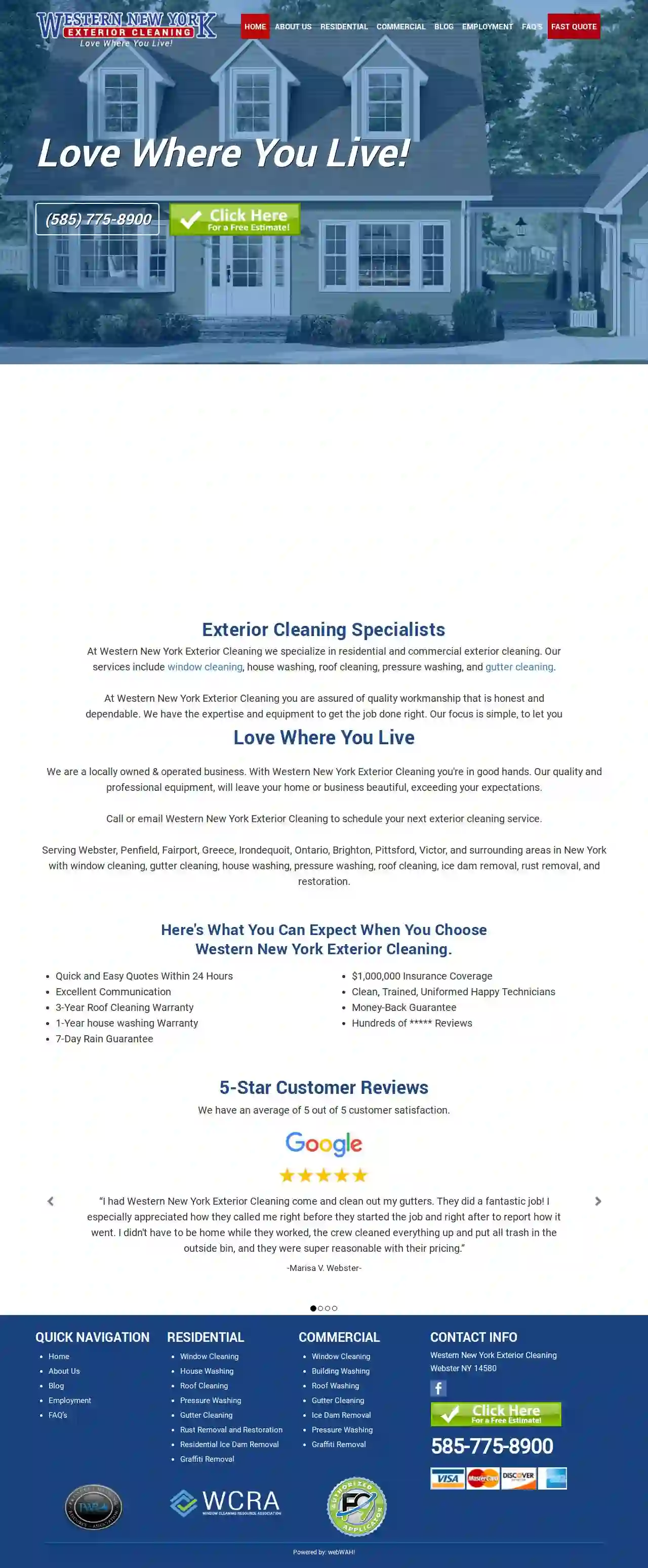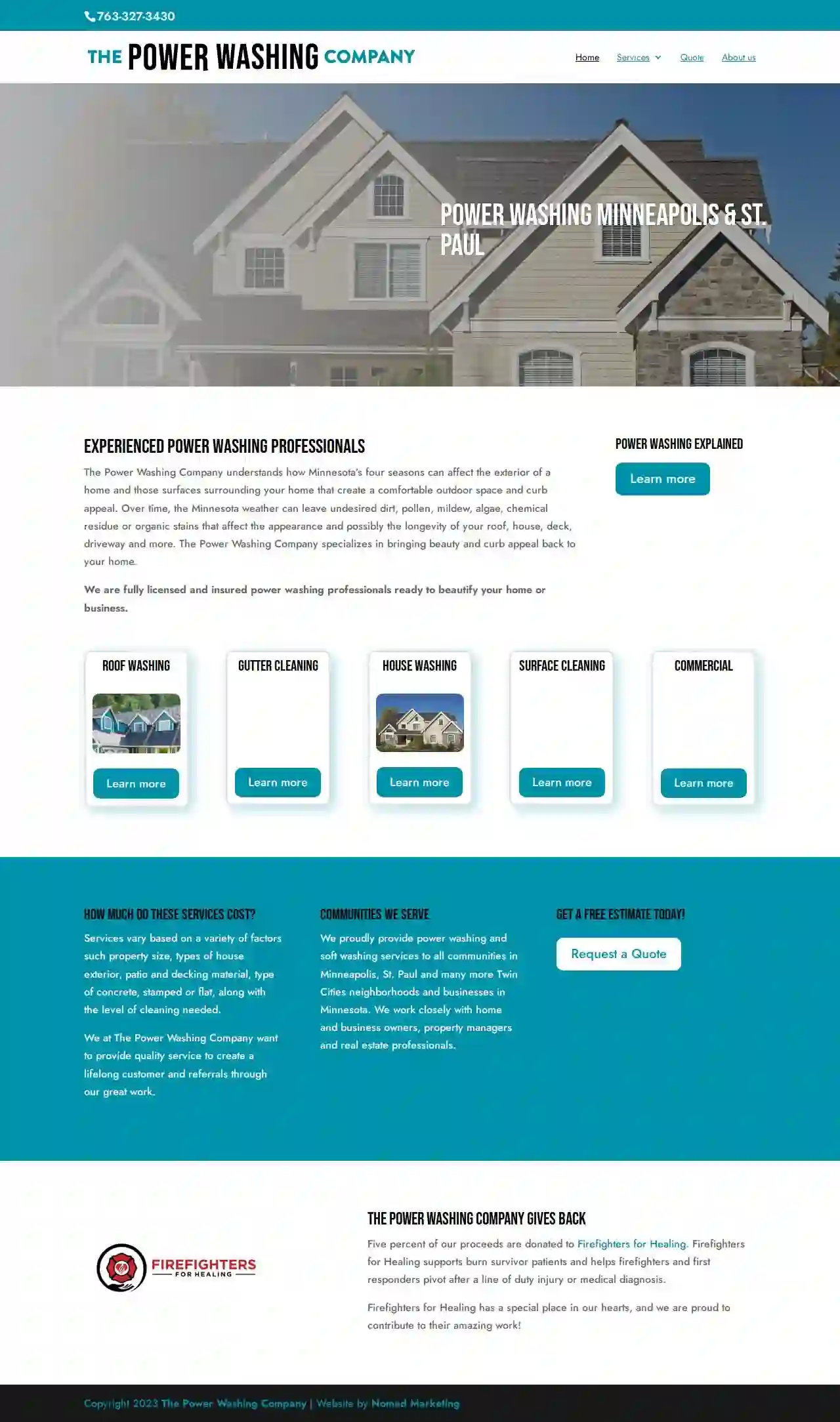Pressure Washing Chanhassen
Find top Power Washing in Chanhassen
Receive 3 FREE Power Washing quotes for your project today! Compare profiles, reviews, accreditations, portfolio, etc... and choose the best service.

Mike's Power Wash
Not provided., Chanhassen, 55317, USMike's Power Wash is a local, family-owned and operated business dedicated to preserving and beautifying homes in the Western Minneapolis area since 1998. They specialize in various services including Cedar/Asphalt Roof Cleaning, Anti-Algae Treatment, House Washing, Deck Cleaning & Sealing, Spring/Fall Gutter Cleaning, Fence Cleaning & Sealing, Cement Cleaning, Roof Snow and Steam Process Ice Dam Removal, and General Pressure Washing. With over 20 years of experience, they offer reasonable rates and have earned multiple awards such as Angie's List Super Service Award Winner, Next Door Neighborhood Favorite, BBB A+ rating, and an Ethics Award Nominee.
- Services
- Why Us?
- Accreditations
- Our Team
- Testimonials
- Gallery
Get Quote
Wash Masters
5146 reviews427 Meadow Rose Court, Delano, 55328, USWash Masters is a family-owned and operated professional window and pressure washing company serving the western suburbs of Minneapolis and the greater Twin Cities area. Established in Delano, MN, they pride themselves on providing a superior and professional service that is second to none. They offer a variety of services including window washing (interior and exterior), pressure washing for various hard surfaces, gutter cleaning, and even Christmas light installation. Wash Masters is committed to 100% customer satisfaction, offering competitive pricing and bonded and insured services.
- Services
- Why Us?
- Our Team
- Testimonials
- Gallery
Get Quote
Top Hat Services - Your Exterior Cleaning Experts
4.9436 reviews7635 W 148th Street, #257, 7635 W 148th Street #257, Apple Valley, 55124, USWe all know how harsh Minnesota weather can be. Having temperature changes of nearly 60 degrees from day to day can be anything but good for the exterior of your home. With that being said, we have made it our mission to give your home or business that one of a kind curb appeal that everybody will talk about. With two locations in Apple Valley, Minnesota and Farmington, Minnesota we are proudly servicing residential homes, townhomes/apartment complexes, and small commercial buildings in the entire South Metro Area. Professional services include window cleaning, house washing, pressure washing, roof washing, and gutter cleaning services. Our experienced, licensed, and insured team of professionals will leave your property looking so fresh and so clean that your home will be the talk of the neighborhood! Whether you’re wanting a routine Spring, Summer and Fall cleaning, having a grad party, hosting an event or just simply looking for that one of a kind curb appeal... we are the ones for the job.
- Services
- Why Us?
- Testimonials
- Gallery
Get Quote
Ecoblast PowerWashing
4.611 reviewsRochester, USTransform Your Property with the Expert Touch of Our Pressure Washing Services Unleash the Beauty in Every Surface Looking for Pricing? Discover More with Ecoblast-Power washing Where we offer a wide range of affordably priced pressure washing services to meet all of your needs. Our company prides itself on being honest, dependable, meticulous, and knowledgeable in our trade. We believe that our competitive edge lies in the quality of service we provide. Our Guarantee We aim to make your experience with us superior to any other company. Our focus on keeping our loyal clients happy is crucial to our business. Recommendations from satisfied customers fuel our growth. Our team is fully insured, and we back our work with a solid 100% money-back guarantee, highlighting our dedication to your satisfaction and commitment to a superior experience. Why Choose Us Why settle for a lackluster exterior when you can effortlessly revive your home's beauty through power washing? At Ecoblast Power Washing, we take immense pride in offering a broad range of budget-friendly, high-quality pressure washing services tailored to meet all your needs. Whether it's vinyl siding, concrete, wood, or any other exterior surface, rest assured we possess the expertise and equipment to deliver exceptional results. Got Dirt? Don't let dirt, algae, and other natural elements accumulate and mar your home's appearance over time. Let Ecoblast be your partner in preserving and rejuvenating your property, all without breaking the bank. Serving the Greater Rochester and surrounding areas, we're ready to transform your home's exterior. Schedule with us today! Eco-Friendly Approach We're committed to environmental responsibility. Our eco-friendly cleaning solutions are safe for your property and the planet. Advanced Softwash Applications Our softwash techniques are gentle on surfaces but tough on grime. We prioritize the long-term health of your property. Cutting-Edge Equipment We invest in state-of-the-art equipment, ensuring the best results for your property without causing any damage. Exceptional Customer Service Our team is dedicated to providing outstanding customer support at every step of your journey with us. Satisfaction Guarantee We stand by our work with a satisfaction guarantee, giving you peace of mind and confidence in our services.
- Services
- Why Us?
- Testimonials
- Gallery
Get Quote
H2Eco Pressure Washers
524 reviewsRochester, USWelcome to H2Eco Pressure Washers, your go-to source for top-quality, trusted, eco-friendly pressure washing services. Our team of experienced professionals is dedicated to providing exceptional service and delivering outstanding results. Using biodegradable chemicals and environmentally safe practices, your property and your assets are treated as if they were our own. We strive to be in constant communication with our customers until the job is done and after. Please contact us to set up your pressure washing service or with any questions on our services. We look forward to working with you! H2Eco Pressure Washers, LLC Established 2019 Rochester, NY (585)734-6774
- Services
- Why Us?
- Our Team
- Testimonials
- Gallery
Get Quote
Western New York Exterior Cleaning
4.9420 reviewsWebster, 14580, USAt Western New York Exterior Cleaning we specialize in residential and commercial exterior cleaning. Our services include window cleaning, house washing, roof cleaning, pressure washing, and gutter cleaning. At Western New York Exterior Cleaning you are assured of quality workmanship that is honest and dependable. We have the expertise and equipment to get the job done right. Our focus is simple, to let you Love Where You Live. We are a locally owned & operated business. With Western New York Exterior Cleaning you're in good hands. Our quality and professional equipment, will leave your home or business beautiful, exceeding your expectations. Call or email Western New York Exterior Cleaning to schedule your next exterior cleaning service. Serving Webster, Penfield, Fairport, Greece, Irondequoit, Ontario, Brighton, Pittsford, Victor, and surrounding areas in New York with window cleaning, gutter cleaning, house washing, pressure washing, roof cleaning, ice dam removal, rust removal, and restoration.
- Services
- Why Us?
- Accreditations
- Testimonials
- Gallery
Get Quote
Space Clean
574 reviewsPittsford, USSpace Clean is a locally owned and operated company that has been providing pressure washing and house washing services in the Rochester, NY area since 2008. We are fully licensed, bonded, and insured. Our team of experts uses state-of-the-art equipment and cleaning agents to provide top-notch services for both residential and commercial properties. We offer a variety of services, including house washing, concrete cleaning, brick paver restoration, deck and fence cleaning, window cleaning, roof cleaning, drive-thru cleaning, and HOA community cleaning. We pride ourselves on our attention to detail and commitment to customer satisfaction, offering a 100% guarantee on all our services.
- Services
- Why Us?
- Gallery
Get Quote
Aqua Blast
59 reviewsTwin Cities, USExterior Cleaning Experts Serving the Twin Cities Metro of Minnesota. Call to Get a Free Quote Now! High-Quality Soft and Pressure Washing Services. Aqua Blast is your local go-to company for exterior cleaning services including power washing and pressure washing services. Our team is fully equipped and insured to perform any type of residential and commercial exterior cleaning projects in the Twin Cities of Minnesota and Western Wisconsin area. Whether you need your home's siding soft washed or a parking lot pressure washed, our soft and pressure washing services will leave your property spotless. We are also experts in gutter cleaning and ice dam removal services throughout the year. We take pride in our work, so when you hire us, you will be in touch with our owner from beginning to end. Trust our team to clean your property right the first time. Why not give us a call at 651-303-4894 for a free estimate today? Get A Free Quote Now!
- Services
- Why Us?
- Testimonials
- Gallery
Get Quote
The Power Washing Company
544 reviews123 Main St, Suite 100, Minneapolis, 55421, USThe Power Washing Company is a fully licensed and insured power washing professional dedicated to bringing beauty and curb appeal back to homes and businesses in Minneapolis, St. Paul, and surrounding areas. They specialize in power washing, soft washing, roof washing, gutter cleaning, house washing, patio and deck cleaning, and surface cleaning. Their services are tailored to meet the needs of each property, considering factors such as size, exterior type, and level of cleaning required. The company is committed to providing quality service and supports Firefighters for Healing by donating 5% of their proceeds.
- Services
- Why Us?
- Accreditations
- Our Team
- Testimonials
- Gallery
Get Quote
Advanced Washing Systems
St. Cloud, MN, USA, 123 Main St, 56301, USAt Advanced Washing Systems, we offer a comprehensive range of industrial and commercial cleaning services to meet the unique needs of your business. Whether you need daily cleaning or periodic deep cleaning, our team of experts can help. We use state-of-the-art equipment and eco-friendly cleaning products to ensure that your business is not only clean but also environmentally friendly. Contact us today to learn more about our services and how we can help your business shine.
- Services
- Why Us?
- Accreditations
- Our Team
- Testimonials
- Gallery
Get Quote
Over 60,241+ Janitorial Companies on our directory
Our cleaning services operate in Chanhassen and beyond!
CleaningMatch has curated and vetted the Best Cleaning Businesses in and around Chanhassen. Find a trustworthy business today.
Frequently Asked Questions About Pressure Washing
- Pressure Washing: For hard surfaces like concrete, brick, or decks, pressure washing can effectively remove mold and mildew. Use a cleaning solution containing bleach or mildewcide for optimal results.
- Soft Washing: For delicate surfaces like roofs or siding, soft washing is the preferred method for mold and mildew removal. Soft washing uses low-pressure water and specialized cleaning solutions to gently remove mold and mildew without damaging the surface.
- Prevention: After cleaning, take steps to prevent future mold and mildew growth by addressing moisture issues, such as fixing leaks, improving ventilation, and trimming vegetation that creates shade and traps moisture.
- Pressure Washing: If your siding is in good condition but dirty or stained, pressure washing can effectively restore its appearance without the need for painting.
- Painting: If your siding is faded, chipped, peeling, or damaged, pressure washing alone may not be sufficient. Painting provides a fresh coat of protection and a new look.
- Pressure Washing Before Painting: Pressure washing is an essential step before painting, as it removes dirt, grime, and loose paint, creating a clean surface for the new paint to adhere to.
- Reputation and Reviews: Check online reviews and ask for referrals to gauge the company's reputation and customer satisfaction.
- Experience and Expertise: Look for a company with a proven track record and experience in pressure washing various surfaces.
- Licensing and Insurance: Ensure the company is licensed and insured to protect you from liability.
- Equipment and Techniques: Inquire about the company's equipment and techniques to ensure they use appropriate pressure levels and cleaning solutions.
- Quotes and Pricing: Obtain detailed quotes that outline all services and costs.
- Professionalism and Communication: Choose a company that is responsive, communicative, and professional.
- Size of the Area: Larger areas generally cost more to pressure wash than smaller ones.
- Type of Surface: Different surfaces require different pressure levels and cleaning solutions, which can affect pricing.
- Condition of the Surface: Heavily soiled or stained surfaces may require more time and effort to clean, impacting cost.
- Accessibility: Difficult-to-reach areas may require specialized equipment and increase costs.
- Additional Services: Services like pre-treating stains, applying protective coatings, or mold removal may incur additional charges.
Can pressure washing remove mold and mildew?
If you have extensive or persistent mold and mildew problems, consult with a professional pressure washing company or a mold remediation specialist.
Is it better to pressure wash or paint my house?
Assess the condition of your siding and your desired outcome to determine whether pressure washing, painting, or a combination of both is the best approach.
What should I look for in a pressure washing company?
A reputable pressure washing company will prioritize safety, use appropriate cleaning methods, and provide excellent customer service.
How much does pressure washing cost?
To get accurate pricing, request quotes from multiple pressure washing companies. Provide details about the size and type of surface, its condition, and any additional services you require.
Can pressure washing remove mold and mildew?
- Pressure Washing: For hard surfaces like concrete, brick, or decks, pressure washing can effectively remove mold and mildew. Use a cleaning solution containing bleach or mildewcide for optimal results.
- Soft Washing: For delicate surfaces like roofs or siding, soft washing is the preferred method for mold and mildew removal. Soft washing uses low-pressure water and specialized cleaning solutions to gently remove mold and mildew without damaging the surface.
- Prevention: After cleaning, take steps to prevent future mold and mildew growth by addressing moisture issues, such as fixing leaks, improving ventilation, and trimming vegetation that creates shade and traps moisture.
If you have extensive or persistent mold and mildew problems, consult with a professional pressure washing company or a mold remediation specialist.
Is it better to pressure wash or paint my house?
- Pressure Washing: If your siding is in good condition but dirty or stained, pressure washing can effectively restore its appearance without the need for painting.
- Painting: If your siding is faded, chipped, peeling, or damaged, pressure washing alone may not be sufficient. Painting provides a fresh coat of protection and a new look.
- Pressure Washing Before Painting: Pressure washing is an essential step before painting, as it removes dirt, grime, and loose paint, creating a clean surface for the new paint to adhere to.
Assess the condition of your siding and your desired outcome to determine whether pressure washing, painting, or a combination of both is the best approach.
What should I look for in a pressure washing company?
- Reputation and Reviews: Check online reviews and ask for referrals to gauge the company's reputation and customer satisfaction.
- Experience and Expertise: Look for a company with a proven track record and experience in pressure washing various surfaces.
- Licensing and Insurance: Ensure the company is licensed and insured to protect you from liability.
- Equipment and Techniques: Inquire about the company's equipment and techniques to ensure they use appropriate pressure levels and cleaning solutions.
- Quotes and Pricing: Obtain detailed quotes that outline all services and costs.
- Professionalism and Communication: Choose a company that is responsive, communicative, and professional.
A reputable pressure washing company will prioritize safety, use appropriate cleaning methods, and provide excellent customer service.
How much does pressure washing cost?
- Size of the Area: Larger areas generally cost more to pressure wash than smaller ones.
- Type of Surface: Different surfaces require different pressure levels and cleaning solutions, which can affect pricing.
- Condition of the Surface: Heavily soiled or stained surfaces may require more time and effort to clean, impacting cost.
- Accessibility: Difficult-to-reach areas may require specialized equipment and increase costs.
- Additional Services: Services like pre-treating stains, applying protective coatings, or mold removal may incur additional charges.
To get accurate pricing, request quotes from multiple pressure washing companies. Provide details about the size and type of surface, its condition, and any additional services you require.